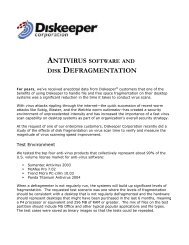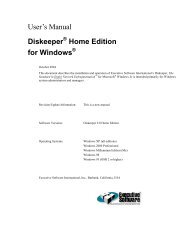Diskeeper 10 User's Manual
Diskeeper 10 User's Manual
Diskeeper 10 User's Manual
Create successful ePaper yourself
Turn your PDF publications into a flip-book with our unique Google optimized e-Paper software.
Glossary 85<br />
<strong>Diskeeper</strong>: A software product that increases system performance through disk defragmentation. It eliminates<br />
resource-wasting file fragmentation safely, by consolidating fragmented files and free space.<br />
diskette: See floppy disk.<br />
domain: In Windows NT, Windows 2000, Windows XP and Windows Server 2003, a group of workstations and<br />
servers, defined by an administrator, that share a common directory database and allow a user to log onto any<br />
resource in the domain with a single user ID and password. Each domain in a network has a unique name.<br />
drive: See disk drive.<br />
drive letter: In Windows and MS-DOS operating systems, the naming convention for disk drives, consisting of<br />
a letter, followed by a colon. Drives A: and B: are normally reserved for floppy disk drives and C: typically<br />
indicates the first hard drive. See also volume.<br />
encrypted file: A file that has been scrambled and made unrecognizable by anyone who does not have the<br />
proper “key” to decode it. The Windows 2000, Windows XP and Windows Server 2003 Encrypting File<br />
System (EFS) allows users to encrypt files and folders on an NTFS volume to prevent access by unauthorized<br />
individuals.<br />
event logging: The process of recording audit information when certain events occur, such as services starting<br />
and stopping, users logging on and off and accessing resources. When running <strong>Diskeeper</strong> on Windows NT,<br />
Windows 2000, Windows XP, and Windows Server 2003 systems, logged events can be viewed with the Event<br />
Viewer utility (in Administrative Tools.) When run on Windows 98/Me systems, <strong>Diskeeper</strong> logs events to a text<br />
file that can be viewed with a variety of text editor programs such as Notepad.<br />
Event Viewer: A utility available on Windows NT, Windows 2000, Windows XP, and Windows Server 2003,<br />
which permits the viewing of logged events. See also event logging.<br />
extended partition: A type of partition that permits the limitation of four partitions per disk drive to be<br />
overcome. A disk drive may be partitioned into a maximum of four primary partitions, or three primary<br />
partitions plus an extended partition. One or more logical drives may be created within an extended partition.<br />
FAT: See file allocation table.<br />
FAT file system: The file system used by MS-DOS and adapted for Windows to store information on disks,<br />
which makes use of a file allocation table. There are three types of FAT file system. The FAT12 (12-bit) is<br />
used on FAT volumes smaller than 16 megabytes in size, such as floppy disks—it is not supported by<br />
<strong>Diskeeper</strong>. FAT16 can be found on all versions of Windows from Windows 95 through Windows Server 2003.<br />
Windows Server 2003, Windows 2000, Windows Me, Windows 98, and the later OSR 2 version of Windows<br />
95 also support FAT32; Windows NT does not.<br />
field: A subdivision of a record in a file. For example, a record in a customer file may contain a name field, an<br />
address field and a phone number field.<br />
file: A complete, named collection of data, such as a program, a set of data used by a program, or a usercreated<br />
document. See also record, field.<br />
file allocation table (FAT): A table or list maintained by some operating systems, to keep track of how files<br />
are stored on a disk.<br />
file system: The method used by an operating system, of naming, accessing and organizing files and directories<br />
on a disk. See also NTFS, FAT file system.<br />
floppy disk: A removable storage medium, consisting of a small magnetic disk made of flexible plastic, housed<br />
in a square protective envelope or cartridge. Originally, floppy disks really were “floppy,” because they were<br />
enclosed in a paper envelope. Also called a diskette, which is a better name for the more recent design that uses<br />
a stiff plastic cartridge. Contrast with hard disk.<br />
formatting: A method of preparing a disk surface for use by placing certain magnetic patterns on it, which are<br />
used by the file system in storing and retrieving data.






